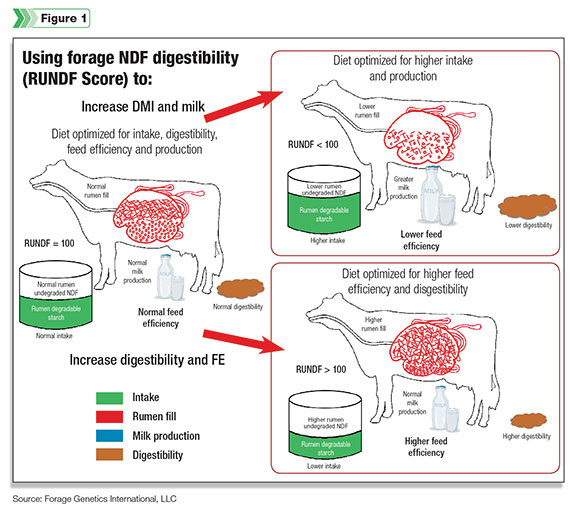Approximately four to five years ago, we saw a steep change in the ingredient markets. Feed prices, particularly corn, skyrocketed. The whole cost structure of operating a dairy jumped without a corresponding increase in milk prices. The impact of these changes continues to play out today.
In light of the changing market conditions, a strategy many dairy producers and nutritionists have leaned on to reduce feed costs is to feed more forages.
This is a solid strategy because if the amount of forages fed can be increased, the amount of purchased ingredients, and therefore the exposure to high prices, can be reduced.
Focus continues to be placed on growing as much forage as possible. The other upside is that forages can be stored at a lower cost on the farm compared to other ingredients like shelled or ground corn.
As a result of these changes, the dairy industry is looking at formulating lactating cow rations with 60 percent or higher inclusion rates for forages compared to diets that were previously formulated with 45 to 50 percent forage.
A key to maximizing milk production at these higher inclusion rates is to pay close attention to the neutral-detergent fiber (NDF) level and digestibility.
Research tells us that milk production and NDF digestibility are intricately linked because forage fiber digestibility drives intake. Dry matter intake (DMI) potential increases as NDF digestibility increases.
A past research review shows that a one-unit increase in in-vitro digestibility of NDF was associated with a 0.37 pound per day increase in dry matter intake (DMI) and a 0.55-pound-per- day increase in 4 percent fat-corrected milk yield per cow.
Most traditional fiber tests measure only crude fiber components (like crude NDF). For the past several years, we have been working on understanding ruminal NDF digestibility to get a better handle on how to best use this data when formulating rations.
Near-infrared (NIR) testing methods can determine ruminal NDF digestibility of the fiber rapidly, which allows nutritionists to respond more quickly with appropriate ration adjustments.
NIR fiber analysis technology is being used in forage testing laboratories to evaluate fiber for NDF digestibility based on an FPN scale.
The FPN scale is an index of ruminal fiber digestibility ranging from 60 (slow or low ruminal NDF digestion) to 180 (fast or high ruminal NDF digestion).
Data from the past six years shows that the ruminal fiber digestibility of corn silage, for example, can vary significantly, ranging in FPN from 112 to 178 with an average of 147.
This added information is important to know when formulating rations because a slower-digesting or faster-digesting fiber will change the amount of fiber that accumulates in or fills up the rumen. If forages are slow or low in ruminal NDF digestion, the rumen will have a high fill potential, particularly in higher-forage diets.
If the forage is fast or high in ruminal NDF digestion, the fill rate will be low. Both scenarios have an impact on intake, milk production and feed efficiency and, if not accounted for, can impact them negatively.
For example, if you have poor-quality forages and the forage comes back with a low NDF digestibility measurement, you could potentially depress feed intake if there is a high inclusion rate of forages in the ration.
At a high inclusion rate, the poorly digestible forage accumulates in the rumen and therefore depresses intakes because digestibility isn’t there.
Forages can be selected for fiber digestibility at planting, but keep in mind that decisions made at harvest can also alter digestibility. For example, a dairy producer could decide to let the alfalfa grow longer so more tons per acre can be harvested.
The higher tonnage is appealing because more feed will be available to the farm. However, because the maturity will be higher, the NDF digestibility will be lower.
In this example, the farm may harvest 10 percent more dry matter per acre, potentially reducing purchased feed cost, but if the lower NDF digestibility is not accounted for, the farm has cost itself milk production because cows will eat less of the forage.
The few cents saved on feed costs may cost the farm dollars if the cows produce less milk. In fact, if NDF digestibility is too low, forage may have to be removed from the diet and replaced with purchased high-fiber byproducts to maintain intake, thereby increasing purchased feed costs.
It’s important to understand that as the maturity of the crop advances, NDF digestibility decreases. The advantage of increased tonnage needs to be balanced with milk production goals.
Get out in front of the problem and make a plan for what crops or forages you are planning to raise and how harvest dates will impact how they will feed.

Once you have an understanding of NDF digestibility, the data can be put to use to either maximize milk production and dry matter intake or increase digestibility and feed efficiency.
Depending upon the quality, amount of feedstuffs and price of milk, the NDF digestibility scores can be used to optimize the diet for individual herds. See Figure 1 .
If we look at the cows represented in Figure 1, each cow represents a different level of NDF digestibility.
The cow on the upper right-hand side is consuming a diet of higher NDF digestibility (or lower NDF) which means that the rumen-undigested NDF (RUNDF) amount, or rumen fill, is lower.
This can lead to a higher rate of passage of feed ingredients through the rumen because of less rumen fill, supporting higher dry matter intakes.
The cow on the lower right-hand side is consuming a diet of lower NDF digestibility (or higher NDF), which means that the RUNDF amount is greater. As a result, passage through the rumen is slower and digestion is higher; as a result, feed efficiency is increased.
The lower right-hand cow may have excessive fill and even lower dry matter intake but have a more complete digestion (and higher feed efficiency) because of the slower passage.
When forages are very tight or feed ingredients are limited and farms do not have enough forage to feed cows, they may consider optimizing the ration for the cow using the strategy on the lower right-hand side of Figure 1.
Adding a less-digestible forage to the ration can fill up the rumen and increase digestibility and feed efficiency – and even reduce intake if desired. In extreme situations, producers have used ingredients like cottonseed hulls, cotton burrs or cotton gin trash to accomplish this goal.
In situations where a dairy possesses enough land to produce adequate amounts of feedstuffs, feed costs tend to be lower. In these situations, and when profit margins are positive, the cow on the upper right-hand side can be more profitable. But in recent years, that has not been the situation most farms have been faced with.
Some dairy producers and nutritionists may prefer to use the NDF digestibility data to increase digestibility and feed efficiency instead of increasing dry matter intakes and milk production.
It’s a matter of putting NDF digestibility data to work to accomplish the goal that best fits the individual herd, their available feedstuffs and prevailing production economics. PD
Weakley has a Ph.D. in animal nutrition from Oklahoma State University and an M.S. in dairy science from the University of Wisconsin – Madison. He is employed by Forage Genetics International and has more than 30 years of experience in ruminant nutrition.
References omitted due to space but are available upon request. Click here to email an editor.

David Weakley
Director - Dairy Forage Research
Calibrate Technologies






